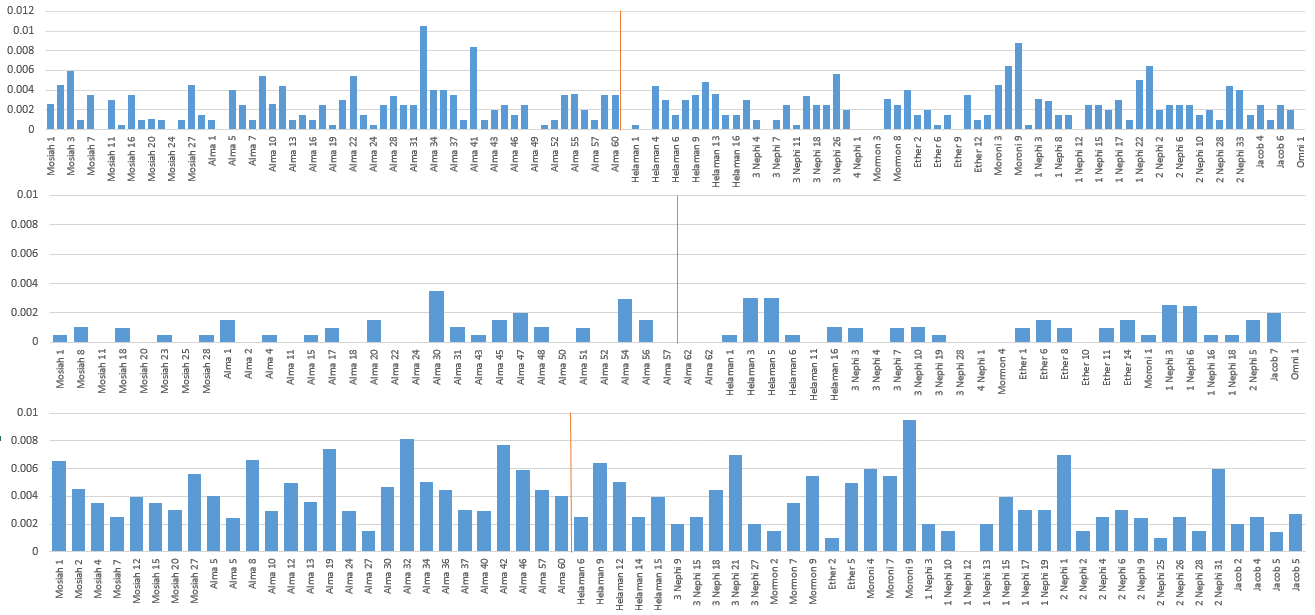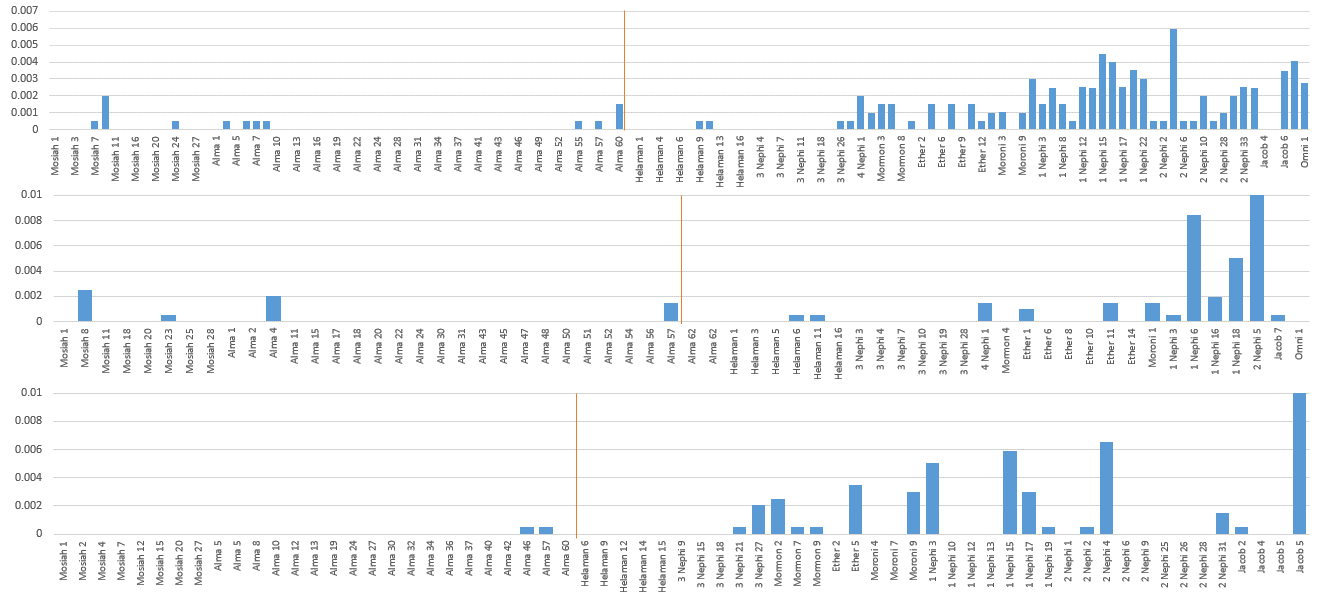Book of Mormon Wordprint Analysis Three Voice Hypothesis
This is an introduction to a series of posts that I will be making to define the Three Voice Hypothesis for Book of Mormon authorship attribution, developed from analyzing Book of Mormon wordprint data.
Most people that read the Book of Mormon seriously intuitively feel like there are multiple voices. For faithful LDS, the explanation is the one the book provides, that there are in fact multiple authors: Mormon, Moroni, Nephi, etc. For some critics of BOM historicity, the Spaulding-Rigdon theory is used to explain this. Single authorship subscribers believe that the multiple voices were created with the intention to give credibility to the book, or may downplay the distinctiveness of the multiple voices. For many, like me, it remains a mystery. I don’t have a good theory as to the ‘why’ there are multiple voices in the Book of Mormon, but through these posts I hope to clearly illustrate the case for the Three Voice Hypothesis.
S Voice (sermon) vs N Voice (narrative)
Using Mosiah priority theory (the theory that after the 116 pages of Book of Lehi were lost, the translation continued with Mosiah and then the small plates were tacked on after Moroni), I will always talk in terms of Mosiah first and the small plates last. The first trend I notice in the Book of Mormon is the distinctiveness between Mormon’s narrative voice and the sermons taught by King Benjamin, Alma, etc. This will be called the N voice and S voice. This endures through the entire book, but the distinctiveness is purest in the first half, so I focus on the first half to illustrate the difference.
Methodology of how I divided S vs N for comparison. This is critical for understanding the project. For the large plates portion, everything in Mormon and Moroni’s voice, I started out dividing into N. I used the tool Voices in the Book of Mormon database created by John Hilton III, Shon Hopkin, Jennifer Platt, Randal Wright, and Jana Johnson. Everything else was designated as S. I then went through and switched back passages from N to S where Mormon and Moroni address the audience and speak in first person as an orator not a narrator. For the small plates, I went through this chapter by chapter. Keep in mind, if you see glitches in the purity of the distinctiveness of the voices in the charts or tables I show, it could be because of faulty allocation between S and N for a portion.
The N voice is written in past tense, passive voice. ie lots of ‘they were’ and ‘he had’. Its focus is to tell a story. The S voice is written in first person, present tense. It focuses on doctrinal exposition, so obviously the vocabulary set will be different. I hope to show the voices are consistent and distinct. The question will be whether this suggests multiple authors or whether it is typical for one author to be able to produce this result.
I will be illustrating tables and charts to show variation in the data but will not attempt to do any statistical studies. Here is a chart showing the frequency of the word ‘if’.

Code: axis on left is the frequency of the term ‘if’. 0.01 would equate to 1 time using ‘if’ per 100 words. 0.001 would equate to one time per 1,000 words. Each bar represents a block of 2,000 words, starting from Mosiah 1 and going to the end of the book and starting over with Nephi. The top chart is the S and N in total combined (Isaiah and other chapter length Bible quotations excluded). The second chart is just the N voice portion isolated. The third chart is just the S voice portions of the book isolated. The orange line is the divider between what I’m calling the first half and last half. For N vs S comparison, I focus on the first half where the S vs N distinction is most pure. The last half of the BOM is where the ‘Late Voice’ is introduced. The orange line is in different locations across the page because the chunks of 2,000 words for each S and N don’t line up exactly. Fortunately, they line up close enough to allow for nice visual comparisons. For the portion Mosiah to end of Alma (left of the orange line), the actual data:

‘If’ appears 5.9 times more often in the S Voice section. Additionally, the frequency appears to have normal variation across S Voice speakers: King Benjamin, Alma, Amulek, Abinadi, etc.
There are dozens of examples like this, which as a whole make what I think is a strong case that these are two consistent, distinct voices.
The third voice: L Voice (Late)
You can call this the Nephi voice, or the Small Plates voice, but it seems to sneak in earlier, starting about the end of Alma. I discovered this by looking at the major narrative voices: Mormon, Moroni, Nephi. I found that Moroni seemed to be a blend of Mormon and Nephi. And Mormon’s voice seemed to be very consistent through Alma and then started to adopt some of these late voice features.
This is characterized by:
- increase of narrator speaking in first person
- more fluidly changing from N vs S, compared to primarily large blocks at a time in the first half
- increase in some of the EmodE grammar as researched by Royal Skousen and Stanford Carmack
- increase in vocabulary related to House of Israel, Jews, Gentiles, etc.
- increase in some random phrases: ‘by the power’, ‘face of the land’, ‘like unto’
- decrease in using some of the peculiar words and phrases strong in the first half: ‘thus’, ‘took’, ‘over the people’
- change in usage of common words and prepositions
Here’s a chart in the same format as the previous one, charting the use of ‘I, X’, as in ‘I, Nephi’, ‘I, Moroni’, ‘I, Mormon’, ‘I, Alma’. The trend is strong in all three: Total, N isolated, and S isolated. This illustrates what I found to be a strong, prevailing trend. The L voice creeps in slowly and then maximizes in Nephi.

The L Voice (as well as S and N) also has distinctive differences in the frequencies of common words and prepositions. I will be publishing findings on this as well, though it will be outside my scope to determine statistical significance of variations. Here is a breakout of the top 25 most common words in the Book of Mormon.
N = N voice Mosiah through Alma. Covering 62,747 words.
S = S voice Mosiah through Alma. Total 53,152 words.
L-N = Late N voice. The narrative portions of Helaman through Moroni and starting again 1 Nephi through Words of Mormon. 57,198 words.
L-S = Late S voice. The sermon portions of the last half. 76,685 words.
| Word | Total | O-N_freqK | S-N_freqK | L-N_freqK | L-S_freqK |
| the | 17,688 | 80.29 | 51.51 | 78.13 | 70.98 |
| and | 15,235 | 64.15 | 48.41 | 74.72 | 56.90 |
| of | 10,932 | 47.40 | 38.31 | 43.62 | 44.69 |
| that | 6,535 | 25.45 | 27.69 | 26.03 | 25.78 |
| to | 6,182 | 34.50 | 21.30 | 29.30 | 15.77 |
| they | 4,295 | 24.35 | 10.35 | 21.15 | 13.13 |
| of the | 3,531 | 16.19 | 8.88 | 15.59 | 15.01 |
| in | 3,437 | 13.13 | 13.09 | 15.32 | 13.58 |
| unto | 3,441 | 7.97 | 13.79 | 12.29 | 19.63 |
| I | 3,049 | 1.27 | 19.53 | 7.71 | 19.43 |
| he | 3,007 | 15.65 | 9.24 | 13.62 | 9.85 |
| it | 2,927 | 12.40 | 7.22 | 16.99 | 10.34 |
| their | 2,668 | 18.33 | 7.22 | 10.93 | 6.64 |
| them | 2,502 | 13.85 | 6.42 | 10.28 | 9.18 |
| for | 2,258 | 6.93 | 10.84 | 6.63 | 11.32 |
| be | 2,214 | 4.14 | 11.46 | 5.28 | 13.60 |
| shall | 1,877 | 0.13 | 9.48 | 0.77 | 17.23 |
| his | 2,066 | 12.00 | 8.03 | 8.34 | 5.33 |
| which | 2,138 | 6.55 | 8.56 | 8.36 | 10.35 |
| a | 1,933 | 7.87 | 9.03 | 6.85 | 7.39 |
| not | 1,896 | 5.85 | 11.19 | 5.61 | 7.99 |
| were | 1,999 | 14.87 | 3.18 | 11.92 | 2.80 |
| ye | 1,851 | 0.08 | 15.88 | 0.66 | 12.57 |
| did | 1,976 | 9.67 | 1.92 | 19.72 | 1.81 |
| all | 1,680 | 6.85 | 6.25 | 7.19 | 6.61 |
Here is my attempt to build a predictive model showing the densities chapter by chapter of each voice, based on frequencies of key phrases and usage of common words. Blue = S, Red = N, Green-Yellow = L. I will explain the methodology here in future posts.

My goal here is to bring insights into the text and possibly the translation of the Book of Mormon.